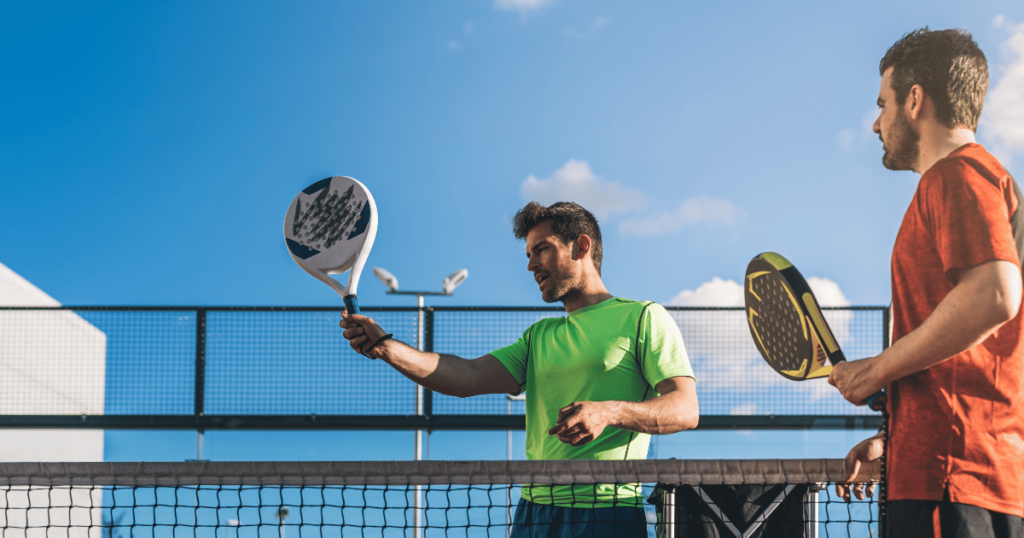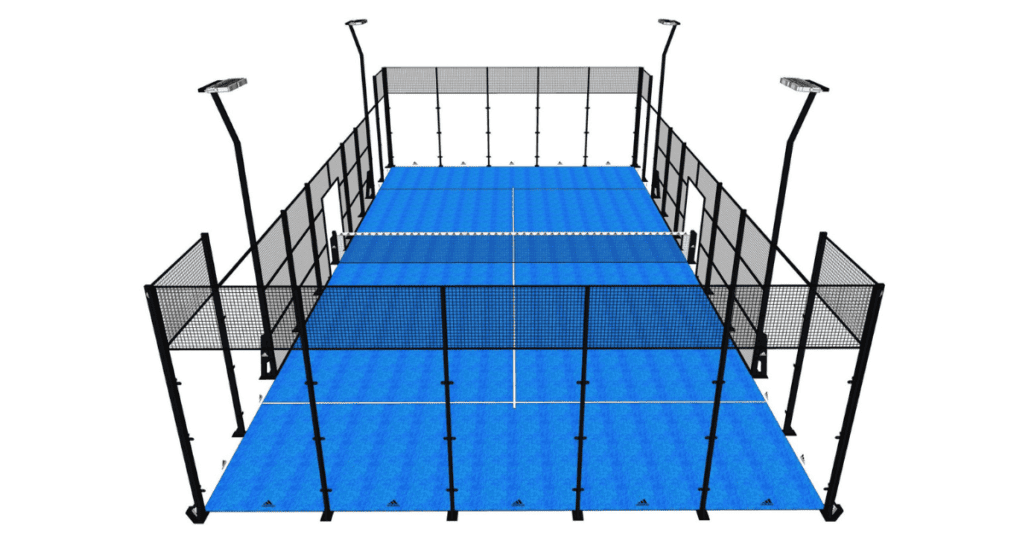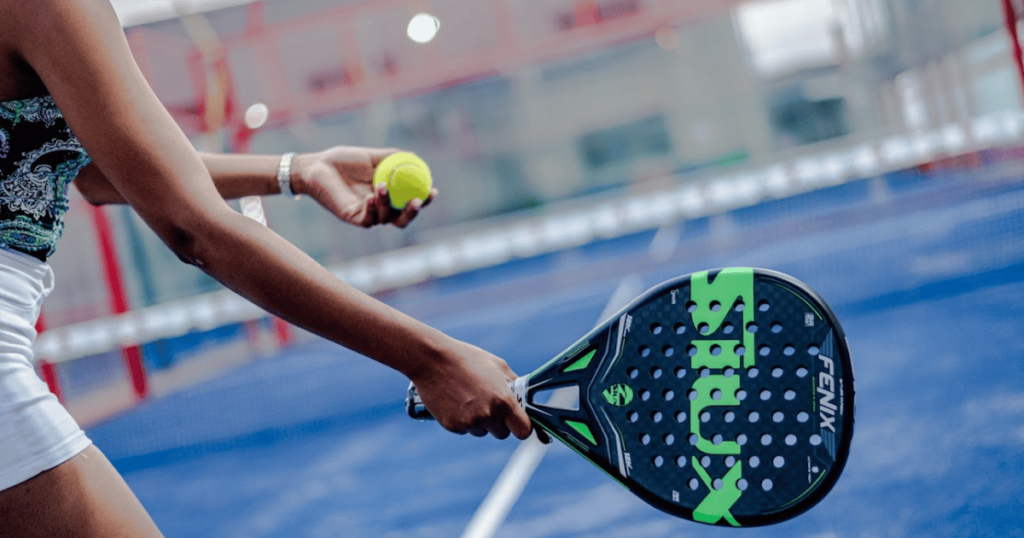Are you ready to dive into the thrilling world of Padel, a fast-paced racquet sport that’s been captivating players around the globe? This exciting game combines elements of tennis, squash, and badminton, offering a unique and exhilarating experience on the court.
In this comprehensive guide on how to play padel, we’ll cover everything you need to know to start playing Padel with confidence, from understanding the basics to mastering the art of serving and beyond. So, let’s gear up and get ready to unlock the secrets of Padel!
Key Takeaways
- Experience the excitement of Padel Tennis: unique court design, specialized rackets & balls, and doubles gameplay!
- Mastering the Padel Court offers thrilling opportunities for strategic play with an enclosed court design.
- Become a successful player by focusing on positioning, movement & shot selection, get ready to experience the thrill of competitive advantage!
Understanding Padel Basics

Originating in Mexico and popularized in Spain, Padel has taken the world by storm with its unique enclosed court design, lively doubles gameplay, and distinctive equipment. Played on a smaller court than tennis and surrounded by walls, Padel encourages high-energy gameplay full of thrilling ball rebounds and strategic shot selection. As the sport continues to grow, the world padel tour showcases the best of this exciting game.
Whether you’re a seasoned tennis player looking for a fresh challenge or a newcomer to racquet sports, Padel sport offers a fantastic opportunity to hone your skills and have a blast on the court. So why not play padel and experience the excitement of padel tennis, even aspiring to join the professional padel circuit?
Padel vs Tennis
Padel has similarities with tennis in court markings and scoring. However, it has unique features. A key difference is the Padel court. It’s enclosed by glass and metal mesh walls. These walls let players use them during gameplay.
This leads to thrilling ball rebounds and surprising shot angles. Think of a tennis ball bouncing off a glass wall. It keeps you alert and challenges your reflexes!
Another notable difference lies in the equipment. Padel rackets are solid, stringless, and perforated, designed to deliver a different feel and ball control compared to conventional tennis rackets. Padel balls, on the other hand, are slightly smaller and have less pressure than tennis balls, which affects the speed and bounce during gameplay.
Overall, the unique combination of court design, rackets, and balls creates a one-of-a-kind playing experience that distinguishes Padel from its racquet sport cousins.
Doubles Gameplay
In Padel, teamwork truly makes the dream work. The game is played exclusively in doubles format, emphasizing collaboration, communication, and strategy between partners. Each team consists of two players who must alternate shots, ensuring that the ball bounces on both sides of the court before a point is scored. This dynamic gameplay fosters a fantastic sense of camaraderie and friendly competition, as players work in tandem to:
- Uutmaneuver their opponents
- Communicate effectively
- Strategize their shots
- Coordinate their movements
All of these elements contribute to the overall success and enjoyment of the game.
Successful Padel doubles hinge on developing a strong rapport with your partner and refining your on-court communication skills. Positioning, shot selection, and synchronization are all essential components of a winning strategy, as players must constantly adapt to the ever-changing conditions of the game. Whether you’re a Padel veteran or a first-timer, working together with your partner to conquer the court and dominate the match is an incredibly rewarding experience.
Mastering the Padel Court

Now that we’ve covered the basics of Padel, let’s delve deeper into the heart of the game: the court itself. Padel courts are enclosed by surrounding glass walls and metallic mesh walls, offering a unique playing environment that sets the stage for exhilarating rallies and spectacular shots. The walls play a crucial role in Padel, as they open up a world of possibilities for creative and strategic gameplay. Players can use the walls to their advantage, creating unexpected angles and forcing opponents to scramble for position.
With its distinctive design and exciting gameplay opportunities, the Padel court is a true testament to the sport’s innovative spirit. A thorough understanding of the unique features of the Padel court, including the walls and playing surface, can significantly augment your game and provide a competitive advantage.
Enclosed Court Design
A standard Padel court measures:
- 20 meters in length
- 10 meters in width
- Enclosed by a mix of glass and metallic mesh walls
- The maximum height of the walls varies, with the glass sections reaching up to 4 meters and the metallic mesh sections ranging from 3 to 4 meters.
A net divides the enclosed court surrounded in half, with a maximum height of 92 cm on the sides and 88 cm in the center. This unique court design creates a dynamic and fast-paced playing environment, where players must think quickly and adapt their shots to make the most of the walls and restricted space.
Playing Surface
Padel courts can feature various playing surfaces, with artificial grass being a popular choice for many facilities. This synthetic turf provides a different feel and bounce compared to a traditional tennis court, adding a new dimension to the game and challenging players to adapt their techniques accordingly.
Developing your Padel skills involves familiarizing yourself with the various playing surfaces and understanding their impact on your shots, footwork, and overall gameplay.
Essential Padel Equipment

To fully immerse yourself in the world of Padel, you’ll need to arm yourself with the right equipment. At its core, the game requires three essential components: a Padel racket, Padel balls, and appropriate clothing. Each piece of gear significantly contributes to your performance on the court, making it vital to choose wisely and invest in quality products.
In the following subsections, we’ll dive into the specifics of each type of Padel equipment, offering guidance on selecting the perfect racket, understanding the unique properties of Padel balls, and dressing for success on the court.
Choosing the Right Padel Racket
Selecting the ideal Padel racket can be a daunting task, given the wide array of shapes, sizes, and materials available on the market. Modern Padel rackets are typically made of materials such as carbon fiber or fiberglass, and come in various shapes, including the traditional teardrop and the more modern diamond shape. The size of the racket also varies, with larger rackets offering more power, and smaller ones providing greater control.
Choosing a Padel racket should take into account your skill level and playing style. Beginners may prefer a lighter racket with a larger sweet spot for easier ball contact, while more advanced players might opt for a heavier racket with a smaller sweet spot for increased precision and power. By selecting a racket that complements your abilities and preferences, you’ll be well-equipped to excel on the Padel court and enjoy the game to the fullest.
Padel Balls Explained

At first, Padel balls seem like tennis balls. However, they’re distinct. They’re a bit smaller and less pressurized. They resemble low compression tennis balls.
Their design is slower and more controlled, this impacts gameplay and shot choices. Less pressure leads to longer rallies. Players focus on finesse and placement, not just power.
Note that Padel balls vary, including types like:
- Normal speed
- High speed
- Training
- Tournament balls
Each type serves a specific purpose and caters to different skill levels and playing conditions. When choosing Padel balls, consider your needs, as well as the type of court in which you’ll be playing.
Dressing for Success
For optimal enjoyment of the fast-paced Padel action, wearing comfortable, breathable clothing that enables freedom of movement is necessary. Lightweight, sweat-wicking materials are ideal, as they help to keep you cool and dry during intense matches.
Opt for shorts, t-shirts, and sneakers that offer a snug yet flexible fit, ensuring that you can move freely and confidently on the court. Dressing appropriately not only enhances your performance but also ensures that you look and feel like a true Padel pro!
The Art of Padel Serving

An effective serve is crucial for success in Padel, setting the tone for the entire point and putting pressure on your opponents from the get-go. Serving in Padel requires mastering the underarm serve technique, which is unique to the sport and demands precision, consistency, and strategic placement. A well-executed serve can catch your opponents off-guard, creating opportunities for quick points and momentum shifts in your favor.
This section explores the intricacies of the Padel serve, focusing on the underarm serve technique and the significance of strategic placement within the service box. By honing your serving skills, you’ll be well on your way to becoming a formidable force on the Padel court.
Underarm Serve Technique
The underarm serve in Padel is a distinctive aspect of the sport, setting it apart from other racquet sports and adding a unique challenge for players to master. To perform an underarm serve:
- Drop the ball and hit it with an underhand motion.
- Ensure that the ball is struck before hitting the ground.
- Execute the serve from the right side of the court.
- Bounce the ball once on the server’s side before hitting it diagonally to the other side.
To excel in the underarm serve, focus on your footwork, positioning, and timing. Practice the technique regularly to improve your accuracy and control, and aim to hit the ball at the highest point of the bounce. By incorporating these tips and dedicating time to practice, you’ll be well on your way to mastering the art of the Padel serve.
Service Box Strategy
Serving strategically to exploit your opponents’ weaknesses is essential for winning points in Padel. By carefully placing your serves within the service box, you can target areas where your opponents may struggle, forcing them to make errors or hit weaker shots.
Focus on varying your serve placement and speed, as this will keep your opponents guessing and make it harder for them to anticipate your serves. By employing an effective service box strategy, you’ll be better equipped to seize control of the point and dominate the match.
Scoring and Rules

Padel scoring and rules closely resemble those of tennis, so tennis fans can easily pick up and enjoy padel games. However, padel rules introduce unique features, like the use of walls and specific tie-break rules, that distinguish it and add an extra layer of excitement.
As you begin your Padel journey, it’s crucial to understand the scoring system and rules for a smooth and enjoyable game.
This section explains the Padel scoring system and points out key rules that set the sport apart from other racquet sports. With a grasp on the intricacies of Padel scoring and gameplay, you can confidently step onto the court and compete.
Scoring System
The scoring system in Padel follows the same structure as tennis. With points progressing from 15 to 30, then 40, and finally to game. Games are grouped into sets, with the first team to win six games claiming the set (provided there is a two-game margin).
If the score reaches 6-6 in a set, a tie-break game is played to determine the winner. This familiar scoring format makes it easy for players of all levels to quickly grasp the flow of a Padel match, allowing them to focus on honing their skills and enjoying the game.
As you gain experience in Padel, you’ll develop a deeper understanding of the scoring nuances that can impact your on-court strategy and decision-making.
Tie-Break Rules
In the event of a tie-break in Padel, the first players to win seven points with a two-point advantage claim the victory. If necessary, the tie-break continues until this margin is achieved, adding a thrilling element of suspense to the match.
During a tie-break, points are counted from zero to three. Numerical values such as “zero,” “1,” “2,” and “3” are used for calling these points. These high-stakes moments can often be the turning point in a match. This showcases the competitive spirit and determination of Padel players as they battle for supremacy on the court.
Tips for Padel Success

Excelling in Padel requires focus on three key areas: positioning, movement, and shot selection. Mastering these aspects of the game can greatly improve your performance, allowing you to outwit your opponents and claim victory on the court. Whether you’re a seasoned Padel enthusiast or a newcomer to the sport, implementing these tips and strategies will set you on the path to success.
The following subsections discuss the significance of positioning and movement on the court and the strategic approach to shot selection. By embracing these tips and dedicating time to practice, you’ll be well on your way.
Positioning and Movement
Optimal court positioning lets you anticipate shots, react faster, and cover more ground, hindering opponent scoring. Lateral and forward movements are key in Padel, enabling side-to-side and net approaches.
Effective communication with your partner is crucial for coordinating position, shots, and strategy. Emphasizing footwork, positioning, and teamwork positions you to outplay opponents and win.
Shot Selection and Strategy
Developing a strategic approach to shot selection is key to excelling in Padel. Utilizing a variety of shots can keep your opponents guessing. This will create openings for you to seize control of the point. Some shots to consider incorporating into your game are:
- Drop shots
- Lobs
- Smashes
- Volleys
Using walls in your shots creates unique angles. This forces opponents into tough positions, elevating your game.
For better shots and strategy, focus on court positioning. Anticipate opponent shots. Practice varied shots to sharpen skills. With experience, you’ll be a stronger Padel player. You’ll outsmart and outplay competitors.
Summary
In conclusion, Padel is an exhilarating racquet sport that artfully combines elements from tennis, squash, and badminton. Consequently, it provides a distinctive and thrilling experience for players of all expertise.
By mastering the basics, understanding the Padel court layout, getting to know the essential equipment, grasping serving techniques, and particularly emphasizing positioning, movement, and shot choices, you’re paving the way for Padel triumph.
Armed with the insights and tips you now possess, it’s time to venture onto the court and flaunt your prowess. Whether you’re an adept professional or a beginner keen to explore a fresh sport, Padel invariably offers a riveting challenge and a prime opportunity to amplify your racquet sport talents.
Therefore, gear up, partner up, and plunge into the vibrant realm of Padel!
Frequently Asked Questions
Is it easy to learn padel?
Learning padel is actually quite easy – all you need is an entry level technique and some time. With a bit of practice, you can be playing in no time!
How does padel game work?
Padel is a fun, fast-paced sport played by two teams of two! Matches are best-of-three and sets are won by the first team to six games with a two game difference. In play, you have to hit the ball without bouncing off the ground and if it lands on your side, you lose a point. Get ready for some serious padel action!
What is padel called in America?
Padel is the official name for the popular paddleball sport in America! So grab your paddles and let’s get started!
What do you need to play padel?
Padel is easy to start playing and all you need is a partner, two special rackets and and a ball. Ready, set, go!
What are the main differences between Padel and tennis?
Padel is an exciting variation of tennis, featuring smaller courts, different racket design and walls for ball rebounds. This allow for a unique underarm serve technique – making it truly unique!
